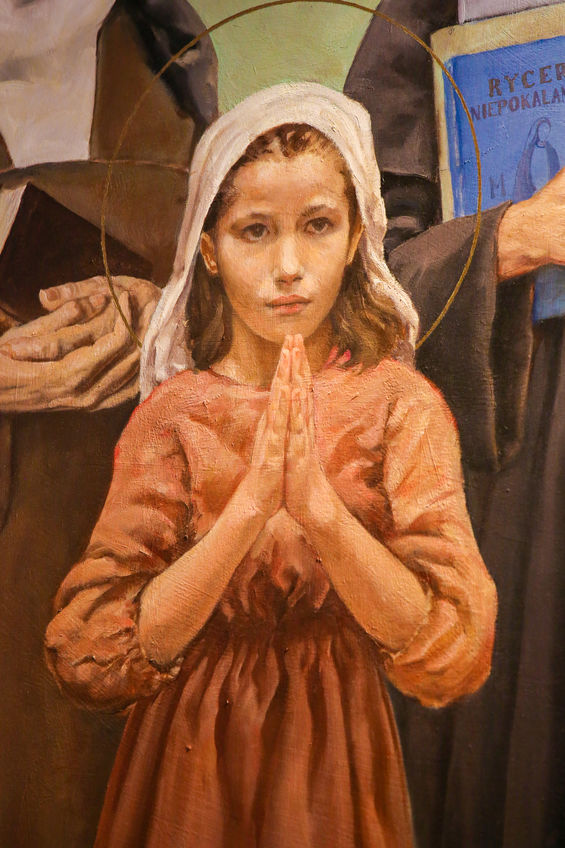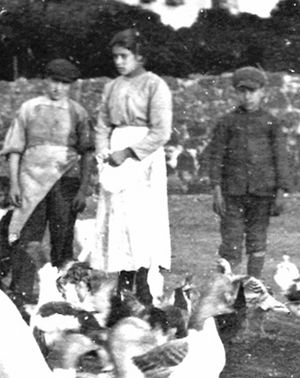If we could have traveled to a poor sharecropping farm in central Italy early in the 20th century, we would have seen a humble building – formerly a cheese factory – sheltering two families of tenant farmers.
One family was headed by Assunta Goretti, recently widowed, with her six children. The second was comprised of a father and son – widower Giovanni Serenelli and 19-year old Alessandro.
Assunta’s husband Luigi had succumbed to malaria, leaving her to assume his farming duties along with her responsibilities for rearing their children.
For help with her onerous burdens, Assunta depended upon her 9-year old daughter Maria, who willingly assumed the running of the household while her mother worked in the fields.
Born on October 16, 1890, Maria Theresa Goretti had grown into an obedient, hardworking child. Her family, despite their constant struggle against grueling poverty, was close and loving, and deeply dependent on God. Faith and hard work were the ties binding the Goretti family – strong, loving ties based on devotion to God and one another.
This was in direct contrast to the family dynamics of the Serenelli men who shared their dwelling – the father, hard-drinking and difficult; the son, undisciplined and quick to raging anger. The young man had suffered much from both parents in childhood and had become overly fond of unsavory companions and unwholesome reading material promoting violence and impure behaviors.
Maria was unable to attend school and never learned to read and write. Still, she had a great devotion to God and willingly walked long distances to attend catechism classes, memorizing the required material and teaching it to her siblings. Her love for the Real Presence and longing for Holy Eucharist were satisfied when she received her First Communion in June, 1901.
July 5, 1902, was a hot day. While her youngest sister napped, Maria sat on the outside steps sewing. Not for the first time, she was approached by Alessandro Serenelli, making lewd advances toward her. Maria had repulsed these in the past, but this time Alessandro dragged her into the kitchen. Struggling, Maria refused him repeatedly – “No! No! It is a sin! God does not want it! You will go to hell!”
Overtaken by a passionate rage, Alessandro threatened to kill Maria, who steadfastly refused to submit. Fourteen times the sharpened file Alessandro wielded was plunged into Maria’s unyielding body.
Miraculously, Maria survived the 7-mile trip to the nearest hospital, and also an unsuccessful surgery performed without anesthesia. During her final agonizing hours, she identified her attacker. Despite her intense suffering, when the local priest asked if she pardoned Alessandro, she replied firmly that for the love of Jesus she forgave him and hoped he would join her one day in Paradise.
After receiving last rites and Viaticum, Maria passed to eternal life on July 6, 1902, three months before her twelfth birthday.
Surly and unrepentant, Alessandro was sentenced to thirty years imprisonment. Some time into his confinement, he dreamed that Maria handed him fourteen lilies, warm and glowing, one at a time – the same number as the wounds he had inflicted on her.
Afterward, Alessandro’s conversion began in earnest. His sentence was reduced by three years for good behavior; after his release, he approached Assunta Goretti and asked her forgiveness. Maria’s mother responded, “Maria forgave you. Christ has forgiven you. Why should I not also forgive you? Yes, my son, I forgive you.”
Alessandro spent the remainder of his long life as a Tertiary with Capuchin Franciscans. His life as a humble gardener and doorkeeper was one of work, prayer, and repentance, begging the intercession of the saintly girl he termed “my good angel.”
Maria Goretti’s canonization on June 24, 1950, was the first to be held outdoors to accommodate the 500,000 in attendance, including her mother and four remaining siblings. At that time, she was the youngest person ever to be canonized. Pope Pius XII held her up as a patroness for youth and a model for the world.
Indeed, the world can learn much from Maria. In the very midst of the horrific attack on her person, she displayed concern for the salvation of her attacker. And later, despite her intense suffering, she summoned the strength to voice sincere forgiveness for Alessandro. Perhaps it was her daughter’s example that influenced Assunta to do the same many years down the road.
The miracle of Alessandro’s total conversion was only one of many, both spiritual and physical, attributed to Maria Goretti. Simple, poor, and uneducated, she was rich in the depth of her spiritual life and the strength of her principles. Today’s youth, immersed in a culture besotted with self-gratification, and confronted constantly by technology tempting them with every kind of immorality, face challenges to purity unimaginable even a decade ago.
To quote Pope John Paul II, “Marietta, as she was lovingly called, reminds the youth of the third millennium that true happiness demands courage and a spirit of sacrifice, refusing every compromise with evil and having the disposition to pay personally, even with death, faithful to God and his commandments.”
© All Rights Reserved, Living His Life Abundantly®/Women of Grace® http://www.womenofgrace.com











